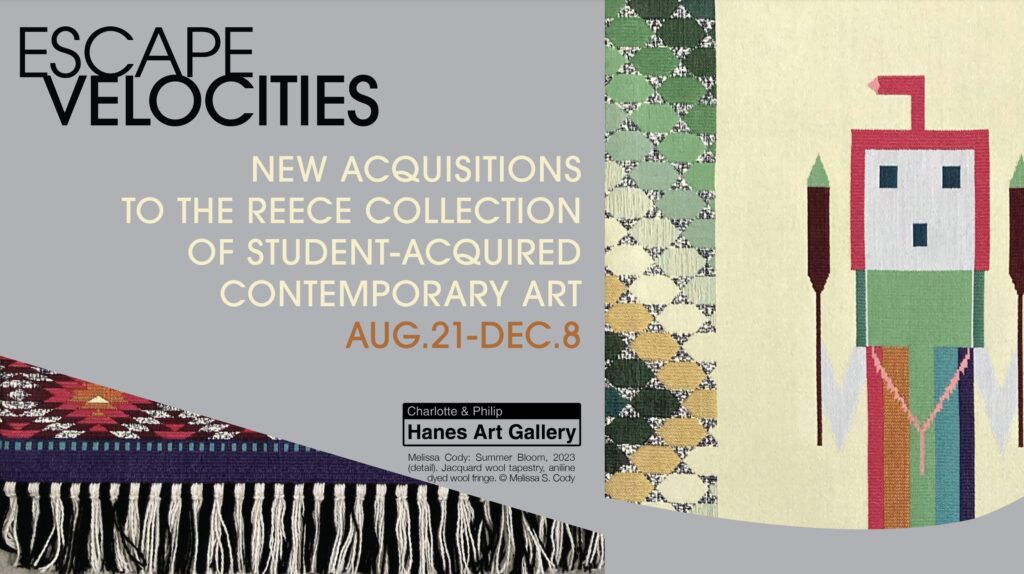Escape Velocities: New Acquisitions to the Reece Collection of Student-Acquired Contemporary Art

Escape Velocities: New Acquisitions to the Reece Collection of Student-Acquired Contemporary Art
AUGUST 21 – DECEMBER 8, 2024
The art selected by the 2024 student members of the Reece Collection Acquisition Committee resists being understood as a cohesive body of work, whether based on approach, medium, style, subject, or other typical measure. What these artists and their work do share is something that would likely have discounted them even in the recent past; their imputed “marginality.” Margins are liminal spaces, determined by “centers” and situated between them and the limits of the edge. The center of art, as with so much else, is currently in flux, shifting and dissolving. When things migrate into our awareness now, they don’t so much constitute a new, monolithic core – as the past “isms” of art effectively did – but rather coalesce into a fluctuant constellation of multiple and diverse points; points of view, points of origin, points of identity, points of concern, points of methodology, points irrespective of the historical center of the art world. These works from the periphery reflect a great yearning to escape the old center and its residual gravitational pull, something approached in each of the selected works on a spectrum from earnestness to humor to joy, with the artists propelling their work along different vectors and speeds to reach escape velocity.
The character and qualities of the works in Escape Velocities, the impulses driving their artists, and the group’s rationale for their selection, are cogently summarized by committee member Jane Alexander: “When selecting these pieces, we all decided to continue the mission of the 2021 buying trip by purchasing only works by minority and women artists. The collection, as it stands, is still largely white and male, notably reflecting the times and culture in which other generations of students purchased for the collection; the Western art world and its literature and criticism has by and large been exclusionary for a long time, but that luckily continues to shift.”
Alexander further describes the group’s decision-making process for the triennial “buying trip,” which adhered to the only stipulation they are given; to select art that “reflects” the students’ three-year slice of “the times.” “When selecting art within this framework, we wanted to focus, in large part, on how the artists’ identities and the social groups they belong to intersect with, and continue in spite of, social power structures that work against them. The pieces range from direct critique of these structures to joy and independence from them. We felt as though these ideas, which have existed in art to some degree for a very long time, are especially important now.”
Additionally, a de-centered diversity of media was specifically sought. “Another particular thing we wanted to do was expand the media represented in our collection. In particular, we were interested in mixed media pieces, which admittedly is something of a catch-all term, and textiles; I’m excited to say that none of our purchased works have the same medium as each other, and many use materials in a particularly thoughtful way to contribute to their content.”
Jennifer Finkel, the Acquavella Curator of Collections who, along with art history Professor Jay Curley served as an advisor to the student acquisition committee, sees the selected works projecting a sense “…of a real, genuine, authentic freedom and liberation. Freedom from boundaries, history, narratives, labels and structures as translated by each artist’s lived experience.”
The 2024 Reece Collection of Student-Acquired Art Acquisition Committee
Advisors:
John J. Curley, Professor, Art history
Jennifer Finkel, Acquavella Curator of Collections
Students:
Jane Alexander (’25)
Sabrina Bakalis (’24)
Brighid Biehl (’24)
Georgia-Kathryn Duncan (’25)
Skyler Edwards (’24)
Roksanna Keyvan (’26)
Jason Farid Najjar (’24)
Xinyu (Lavender) Wang (’25)
Opening Reception
September 24, 6:30-8:30 PM
Related Links
More Information about the Mark H. Reece Collection of Student-Acquired Contemporary Art

